What to do if a gas stove passes gas: causes of gas leakage and their elimination
We are sure that you have often heard a pungent smell from the burners. The stench does not mean that the gas stove passes gas - what you do in such a simple situation, you probably know. The first steps in a gas leak are taught back in school, but you and your children will be better off if you read more about this.
Critical situations are also not uncommon. The likelihood of an explosion decreases as residents quickly and accurately find the leak, eliminate its cause. It is necessary to study this area at least in order to completely eliminate the risk, right?
If you read the article, you can determine the cause of fuel leakage by one or two signs. In a short amount of time, you can prevent the worst case scenario. Individual actions require the intervention of gas workers and craftsmen, and some can be repaired on their own. Find out what exactly.
The content of the article:
Why does a gas stove let gas through?
Gas stoves consist of many tubes and assemblies. Any threaded connections lose density over time, and a certain amount of fuel will leak through them. The functionality of modern stoves protects against many unpleasant moments, but even they allow gas to pass through. If you constantly use household tools, then effectively and relatively quickly eliminate the leak.
Traditional gas stove has a hob with burners (burners), control knobs, grill, lid and oven. The operation of the equipment is affected by the correct installation, parts, and build quality. Due to breakdowns and equipment problems, gas may partially escape.

The owner should find out exactly where:
- through burners and their nuts;
- handles that control the burners;
- gas stove shut-off valve;
- hose or place of its connection;
- internal elements.
Unauthorized leads to problems plate installationwhich security rules prohibit. For old gas stoves, some kind of violation of insulation is the norm. It is better to replace or repair equipment through a service center. A defective cooker in the on state cannot be left unattended. You can rely on built-in protection, but only for a short time.
Consumers encounter leaks if the valve plug lacks lubrication or the tap itself loosens. Nuts often loosen and seals wear out. It is not easy to solve such difficulties, but internal failures also cause great difficulties.
A faulty burner is simply no longer used if it is not possible to repair or replace it with a new one. Gas escape through burners occurs when the stove is misused. For example, if liquefied gas is supplied to a device under a gas network.
How to understand that a stove poison gas?
A person does not feel the smell of natural gas. The safety of household stoves is enhanced by odorant ethanethiol (ethyl mercaptan). The odorant emits a pungent unpleasant odor. Due to combustion problems, carbon monoxide appears. It is also unpleasant, but does not indicate a leak of domestic gas directly.
When there is a choice, ventilate the kitchen or keep it closed to hear extraneous odors, it is better to stop on the first option.

Worries about a leak is when the smell of ethanethiol is held in the air for more than 5 minutes, especially when cooking. The gassed room is aired. Natural gas will gather in the corners, so it makes no sense to focus on fragrance. Waving a hand will not give anything.
You can learn about the condition of household appliances in 3 other ways:
- plate manipulations;
- leak test;
- by the sound.
To check the burners, turn off the hob. If there is an odor of odorant near the burners or it intensifies, there is a leak in this place. On modern stoves are valves that protect against excessive gas flow into the burner and block the fuel when the fire goes out.
The accumulated gas will still make itself felt. Methane with impurities will gather under the hob, and the owners will hear it next to the control knobs, joints of the control panel. In a dangerous situation, emergency personnel will help.
The plate should be moved away from the wall. An increased odor will indicate a leak at the unit connection. If there is no visible damage, then simply replace the gaskets. New hoses and fittings will be needed in case of a serious defect.
The state of the faucet plate is determined by the smell of an open oven. Its strengthening means a violation of the density in the parts, possibly a lack of lubrication.
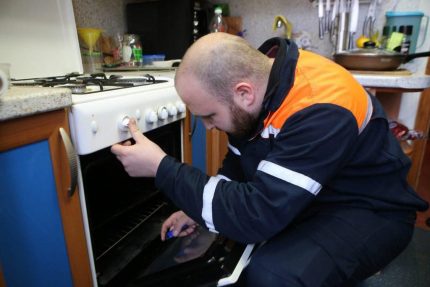
Leak testing provides comprehensive leakage information. Use a solution of dishwashing detergent or soap. Apply to threaded connections of a gas pipe, hose, pipes under the burners. When the first bubbles appear, it makes sense to block the gas and call the gas workers. The wizard will determine all the problem points himself.
Gas does not come out silently, so you can create conditions of silence. The pressure in the unit poisons everything unnecessary outward, and a person can find an approximate leak site. The strongest and most dangerous fuel movements are accompanied by a whistle. In a room with a distinct gas sound, open the window wide and close the door. At the other end of the home, the owners will be most secure.
Ways to fix a gas leak
Gas workers sometimes violate the installation rules, because of which there are leaks, interruptions in the flow of gas. You cannot reinstall it yourself. Re-installation requested from company - parties maintenance agreement.
In the case of leaks in the internal components, the equipment is disconnected from the gas supply and disassembled; problematic connections are tightened more tightly. You can act alone, but it’s better to give the work to the masters who know how to fix a specific model of the stove.
First, they prepare sealing materials, gaskets, pastes, linen towels, as well as tools and accessories for the stove. All this can come in handy.
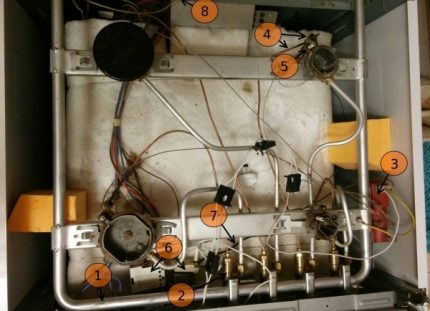
On their own repair the adjustment panel, burners and hose eyeliner. In the case of a shut-off valve on the lower edge, it is better to contact the gas workers immediately. The problem with the crane arises due to lack of lubrication, wear of gaskets, looseness.
To breakdown inlet tube many factors lead. Its seals crack, decrease in volume, wear out. Parts of the hose lose their integrity or tightness. The eyeliner can not be constantly moved or touched, put pressure on it. Burners need timely cleaning, panel handles need adjustment.
If everything that you can do with your own hands has been tried, and the gas stove still lets in fuel, then the parts need to be assembled in their original position. Then the gas workers will not have questions.
The gas supply is affected by the size of the burner nozzle. For fuel from the gas network, choose a larger diameter. Smaller nozzles will be better for vehicles that run on cylinders.
When pipelined fuel is fed through narrow nozzles under liquefied gas, the burners go out, which can cause emissions. In the opposite situation, when gas comes from cylinders and passes through a wide opening, the smell in the room worsens greatly. The justification for using other nozzles is determined by the internal design of the plate.
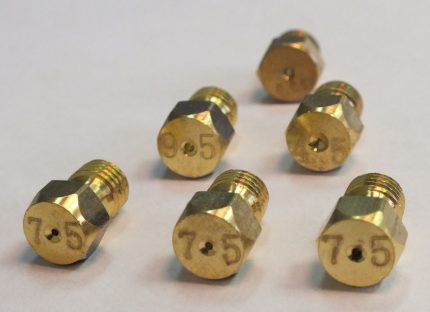
If the furnace runs on cylinders, and there are no leaks anywhere, it’s worth checking the capacity. The leaking necks are covered, wrapped with a wet canvas, taken out of the house or placed on the far side of the housing.
In the event of a leak at the connection between the tank and the tube, the joint is isolated with 4–5 turns of a well-moistened rag. The container is left in place. The emergency gas service will deal with the problem. The hose is left in the stove or blocked with a pointed wine cork at the outlet.
In some stoves, ovens also run on gas. The hobs of the old ovens often go out, thereby endangering the owners.
Method number 1 - elimination of leaks leaks
Temporary burner tightness problems are considered the norm. The regularity of this situation cannot be explained by the specific cause of the leaks. First of all, burners cleanse and eliminate fat. The sodium contained in the microparticles shines with a bright yellow tint at high temperatures. The substance thereby creates the false impression that the device is not working properly.
Burners lose density due to nuts. In this situation, they act simply: they shut off the gas, and tighten the fasteners all the way. With old plates, this defect often happens, so you need to be careful with tools, damage the thread - it means to make it even worse.

Sometimes gas escapes through the supply pipes. To check if there is a leak, turn off the gas and remove the hob from the stove. The movement of fuel is determined by ear or with a soap solution. If the bubbles went, then you have to tighten all the pipe fasteners more tightly.
Method No. 2 - repair of plate handles
In this situation, they partially act independently.Together with the leak, the handles begin to scroll more difficult. Both difficulties are eliminated by lubricating the control panel mechanism.
The order of independent actions looks like this:
- We block the gas.
- We remove the fasteners and remove the control panel and handles.
- Separate the flywheels from the console frame.
- We get the pin that holds the stem.
- Somehow we fix the position of the cork and the spring, so that in the future to install them as needed. We take out these elements.
- We remove the old grease and dirt from the cork. We do without needles and needles. Damage and scratches will intensify leakage in the future.
- Lubricate the cork with a new tool, bypass the holes.
- We clean the stock. We use dry wipes.
- We put the cork as it should, then the spring, at the end we install the stem. Points 4–9 are repeated for each handle.
- We connect a semi-assembled panel without knob caps. Check her work.
- We install the handles and fully assemble the stove.
If the stove continues to let gas through, then you need to immediately call 112 or 104.
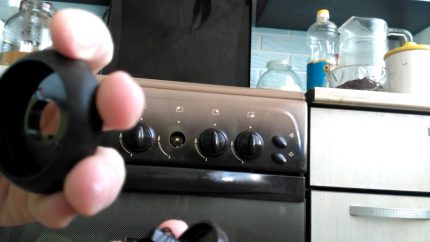
When reassembling, they sometimes experience a problem with a flying rod. The part pops out of the cork if there is an imbalance in the stud connection or serious damage to the thread.
Method number 3 - replacement of the stopcock
The problem arises on different plates, including new and old. The valve is better to replace. For work, you need a gas key for the stove (No. 1) and the crane (No. 2). All this concerns the valves between the lowering and the supply of the plate, in no case those that are in the middle of the lowering or the pipe from which it leaves.
Proceed as follows:
- First shut off the valve.
- We take a key No. 2 and we catch the crane.
- Using the No. 1 wrench, grab the union nut to the plate and unscrew it. We work so that the eyeliner does not spin.
- Take a ring tightened with soapy water. We bring to the outlet branch of the crane. The bubble began to inflate - we called gas workers. There is no movement - you can try to do everything yourself, but only with experience.
Until the gas master arrives, you should buy a new faucet, flax for sealing, and paste for flax. The gasman will unscrew the valve, close the pipe and isolate it. It will take seconds to install a new crane.
The gasman will connect the new valve to the pipe, set the tap handle in the desired position, connect the stove hose and check the tightness of the connection with soapy water. The joint is usually coated with oil paint.

Before valve replacement on your own is worth checking the speed of action. How quickly you manage to lower a wet cloth into a cut half-inch pipe and wind a sealing flax on its thread.
As a result, you will have to remove the old tap, quickly close the pipe and seal it. Then - bring the valve, remove the plug and quickly, but carefully screw it. After - connect the hose for the stove.
In the process, resort to small "tricks." The old valve is not removed immediately, but partially unscrewed. The entrance is plugged with a wet rag. Gas will leave in a minimum amount. The hole can still be closed with a palm. The position of the partially unscrewed valve is kept constant relative to the axis, otherwise the thread may suffer. Before mounting, the flywheel is removed from the new crane. This is done for faster installation and always in the closed position of the handle.
Method number 4 - replacement of gas eyeliner
Tubes for supplying gas to the stove are indicated by a yellow shell or inclusions, sometimes stickers of this color. Hoses are metal corrugated with a plastic coating and rubber with metal thread or braid.
The first option has a longer life, but prone to damage segments.Both types of hoses sometimes poison gas, often at the point of attachment. The insulation of the tubes deteriorates, damage appears next to the fittings and along the entire length.
With small defects, the insulation is restored. In case of serious damage and violation of the integrity of the connecting nodes resort to replacing the hose.
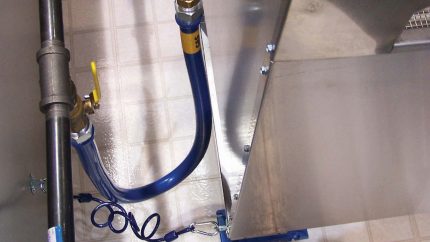
The gas etching tube, on which there is no damage, is repaired and done in 2 ways. Worn gaskets replace. If it does not help, go to the second method - cover the thread with linen with sealing impregnation.
It is impossible to hide the gas hose in the casing, so if there are visible defects or they are not there, but the gas continues to exit, then the tube will have to be changed.
We connect a new eyeliner like this:
- We put a gasket on the hose fitting and screw it into the stopcock. By external or internal thread, depending on configuration.
- We bring the tube to the exit of the plate. With a 3/8 ″ (inch) assembly diameter, use a 1/2 ″ transitional foot, i.e. the size of the hose. We also seal the direct connection or adapter with a gasket.
- Connect the hose directly to the plate collector or to the foot. We work with an open-end wrench.
- We check whether there will be a fuel leak. Lubricate all the links with soap and water and turn on the gas.
The best gaskets for these purposes are considered paronite with a metal mesh against pollution. On the side of the connection to the plate, a lot depends on the directness of the angle or its inclination. It is worth following this and connecting so that there is no bending.
A direct outlet is inconvenient for a hose, and then a metal square is also installed. On the side of the crane at the lowering, additional structures are installed only with the permission of the gas service.
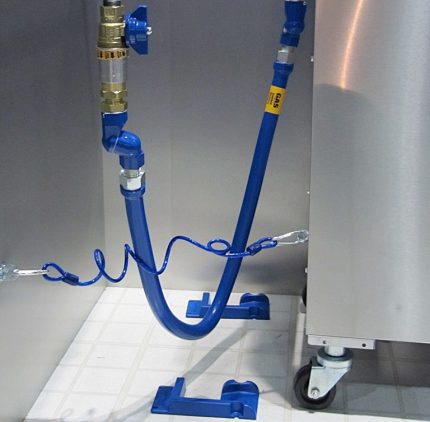
Do not hide the hose behind stationary panels or sheets, for this use collapsible boxes. Tubes must not be painted anywhere other than joints. Colored eyeliners sometimes crack.
With detailed instructions for replacing a gas hose with your own hands, you can read in this stuff.
Conclusions and useful video on the topic
Dismantling a gas stove to find a leak:
Lubricating the cranes of the control handles to eliminate or prevent leaks:
Leakage under cooking - greasing, installing gaskets, tightening nuts and checking for leaks:
You have learned what to do if the gas stove began to let gas through, you read about the causes of the leaks. In an unpleasant situation, the main thing is to remain calm and find the point where there are problems with tightness.
Fuel is burned by burners, control knobs, a shut-off valve and a supply hose that is connected to the tap. You can determine the leak visually, by sound and smell, by checking the traction and special manipulations. Normally, there should be no leaks, so immediately think about the operating conditions. Excessive loads on the parts and inaccurate installation by the gasman will sooner or later lead to malfunctions.
If you had to eliminate a gas leak - tell us about your experience. Write how serious the problem was and how you solved it, if you needed the services of repairmen. Leave comments on the topic of the article. The contact form is located below.

 Where to call if there is no gas in the apartment: reasons for disconnection + procedure for the absence of gas
Where to call if there is no gas in the apartment: reasons for disconnection + procedure for the absence of gas  What to do and where to call if there is a smell of gas at the entrance? Leak Detection Procedure
What to do and where to call if there is a smell of gas at the entrance? Leak Detection Procedure 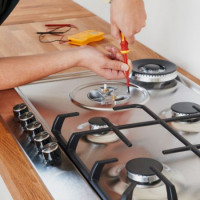 Why a gas stove is shocking: popular reasons and recommendations for their elimination
Why a gas stove is shocking: popular reasons and recommendations for their elimination 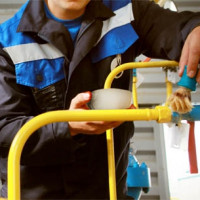 Gas leak: where to call, what can and cannot be done if the apartment smells of gas
Gas leak: where to call, what can and cannot be done if the apartment smells of gas 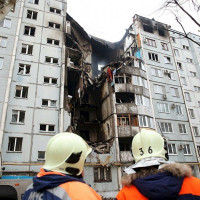 How gas explodes in an apartment: causes of explosions and tips for safe use of gas
How gas explodes in an apartment: causes of explosions and tips for safe use of gas  Actions for the smell of gas in the boiler room: what to do when a characteristic odor is detected
Actions for the smell of gas in the boiler room: what to do when a characteristic odor is detected  How much does it cost to connect gas to a private house: the price of organizing gas supply
How much does it cost to connect gas to a private house: the price of organizing gas supply  The best washing machines with dryer: model rating and customer tips
The best washing machines with dryer: model rating and customer tips  What is the color temperature of light and the nuances of choosing the temperature of the lamps to suit your needs
What is the color temperature of light and the nuances of choosing the temperature of the lamps to suit your needs  Replacement of a geyser in an apartment: replacement paperwork + basic norms and requirements
Replacement of a geyser in an apartment: replacement paperwork + basic norms and requirements
If there is any suspicion of a gas leak, first of all you need to open the windows and prevent it from gaining a dangerous concentration. And after that it is worth calling professionals. It’s dangerous to climb yourself.
Hello. If there is any suspicion of a gas leak, you should first shut off the gas in the valves on the pipe, and only then open the windows and call specialists.